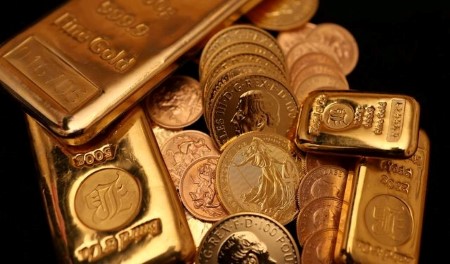Gold hit a record high for the fourth straight session on Thursday and soared past USD 4,300 an ounce as investors flocked to the safe-haven metal on brewing US-China trade tensions and the US government shutdown, with rate cut bets fueling the momentum.
Spot gold was up 2.6% at USD 4,316.99 per ounce as of 4:07 p.m. ET (2007 GMT) after bullion touched a record high of USD 4,318.75 earlier.
US gold futures for December delivery settled 2.5% higher at USD 4,304.60, after touching a record high of USD 4,335/oz.
The yellow metal has gained over 60% year-to-date, driven by geopolitical tensions, aggressive rate-cut bets, central bank buying, de-dollarization, and robust ETF inflows.
“Gold’s trajectory will hinge on the rate-cut picture heading into 2026 as well as the developments around US-China. If no deal is reached between the US and China and the relationship continues to deteriorate, that could be the spark gold needs to cross the USD 5,000/oz barrier,” said Zain Vawda, analyst at MarketPulse by OANDA.
Investors this week have stayed focused on the simmering US-China trade spat, with Washington on Wednesday criticizing China’s expanded rare earth export controls as a threat to global supply chains.
Meanwhile, Donald Trump said he and Russian President Vladimir Putin agreed on Thursday to another summit to discuss ending the war in Ukraine, one day before the US president was due to speak with Ukrainian leader Volodymyr Zelenskiy.
Traders are pricing in a 25 basis-point US Federal Reserve rate cut in October, and another in December, with probabilities of 98% and 95%, respectively.
Non-yielding gold typically performs well in a low-interest-rate environment.
Short-term pullbacks in gold are likely to be temporary, as bullish investors tend to use dips to re-enter positions, Vawda said.
HSBC raised its 2025 average gold price forecast to USD 3,355 an ounce on Wednesday, citing safe-haven demand from geopolitical tensions, economic uncertainty, and a weaker US dollar.
Meanwhile, the ongoing US government shutdown has halted scheduled economic data, with a Treasury official warning it could cost the economy up to USD 15 billion a week in lost output.
Spot silver rose 1.8% to USD 54.04 per ounce, after hitting a record high of USD 54.15 earlier in the session, tracking gold’s rally and supported by tightness in the spot market.
Platinum rose 3.2% to USD 1,706.65 and palladium climbed 4.6% to USD 1,606.00.
(Reporting by Sherin Elizabeth Varghese in Bengaluru; Editing by Vijay Kishore and Shailesh Kuber)







 DOWNLOAD
DOWNLOAD













